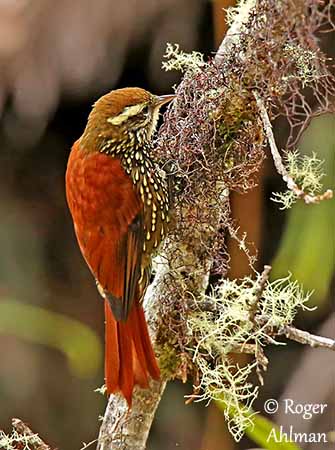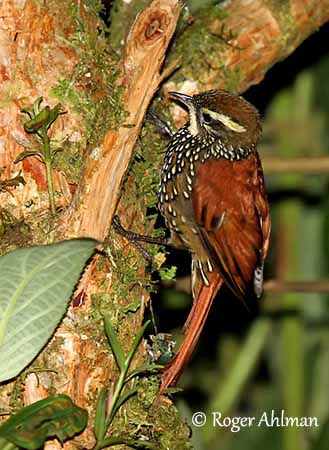
Fr: Anabasitte perlée
Ang: Pearled Treerunner
All: Südlicher Perlstachelschwanz
Esp: Subepalo Perlado, Corretroncos Perlado, Pijuí Perlado
Ita: Corridore arboricolo perlato
Nd: Parelboomloper
Sd: Pärlträdlöpare
Photographer:
Roger Ahlman
Pbase Galleries Peru and Ecuador
Text by Nicole Bouglouan
Sources:
HANDBOOK OF THE BIRDS OF THE WORLD Vol 8 By Josep del Hoyo-Andrew Elliott-David Christie - Lynx Edicions - ISBN: 8487334504
A GUIDE TO THE BIRDS OF COLOMBIA by Steven L. Hilty and William L. Brown - Princeton University Press – ISBN 069108372X
BIRDS OF SOUTH AMERICA – Passerines - by Robert S. Ridgely and Guy Tudor – HELM Field Guides – ISBN: 9781408113424
BirdLife International (BirdLife International)
Wikipedia, la enciclopedia libre
The Guardian - Mystery bird: Pearled treerunner, Margarornis squamiger
The nest of the Pearled Treerunner by Harold F. Greeney and Rudy A. Gelis
Pearled Treerunner
Margarornis squamiger
Passeriformes Order – Furnariidae Family
INTRODUCTION:
The Pearled Treerunner is a lovely member of the family Furnariidae of the Andean Forests, an acrobatic and arboreal feeder with boldly patterned plumage. The name “treerunner” comes from its foraging behaviour when the bird creeps along branches and hangs upside down.
It is resident and favours the high-elevation evergreen forests, and especially the trees covered with moss and epiphytes where it can find numerous arthropods.
The Pearled Treerunner is fairly common in its mountainous forest habitat above the treeline.

The subspecies M.s. perlatus is displayed on this age.
This race has whitish (not yellowish) supercilium, and slightly whiter spotting on the upperparts.
DESCRIPTION OF THE BIRD:
Biometrics:
Length: 15-16 cm
Weight: 14-19 g
The adult of nominate race has bright rufous-chestnut upperparts, including uppertail-coverts and tail. On the upperwing, the primary coverts are darker, and the flight feathers are dark brown with rufous edges.
On the underparts, chin and throat are yellowish-buff. Neck sides and rest of underparts are olive-brown with conspicuous creamy-white teardrop-shaped spots, each narrowly encircled with black. This pattern is heavier on the breast, and becomes elongate, narrower and less distinct towards belly and vent. These spots are longer on the darker rufescent flanks, and appear like buff-yellowish streaks outlined blackish on the undertail-coverts.
The tail is graduated and rather long, with protruding stiffened shafts and lacking barbs, curving downwards. This feature is adapted to the foraging behaviour of this species.
On the head, the crown is browner than the upperparts. We can see a conspicuous eyestripe and a reddish-brown postocular line. The moustachial area shows indistinct tiny spots merging into the collar.
The two-tone bill has greyish-black upper mandible and pale pink lower mandible often with dark tip. The eyes are dark brown. Legs and feet are brownish-grey.
Male and female are similar.
The juvenile has more irregular breast pattern, and the throat feathers have dark tips. The crown is less uniform.
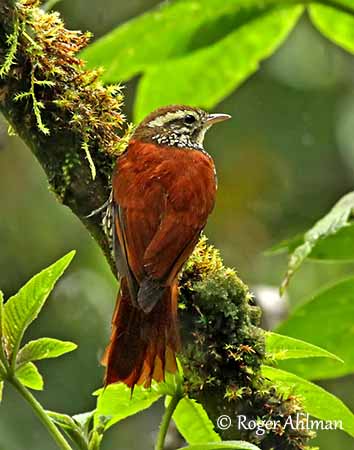
SUBSPECIES AND RANGE:
The Pearled Treerunner has three recognized subspecies.
M.s. perlatus (here displayed) is found in Perijá Mts and Andes of W Venezuela, Colombia, Ecuador and N Peru, N of Marañón River.
This race has whitish (not yellowish) supercilium, and slightly whiter spotting on the upperparts.
M.s. peruvianus occurs in the Andes of N and C Peru, S of Marañón River.
This one differs from nominate by the olive-brown crown, much less yellowish spotting on the underparts, yellowish supercilium, less rufous but more heavily streaked auricular.
M.s. squamiger (described above) is found in the Andes of S Peru and Bolivia, and there are some records in NW Argentina.
HABITAT:
The Pearled Treerunner occurs in humid upper temperate zone forest, forest borders, dense highland hedgerows and woodland above the treeline, mainly Polylepis woodlands.
It favours trees covered with epiphytes and mosses in stunted temperate forest at high elevation, between 2500 and 3500 metres, but generally from 1500 up to 3800 metres of elevation.
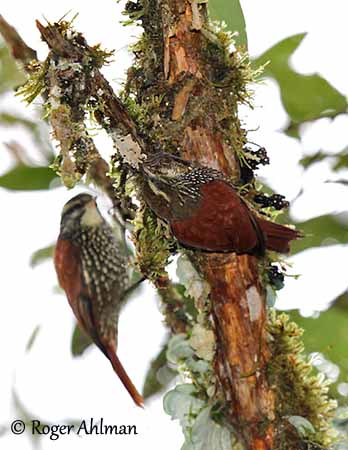
CALLS AND SONGS: SOUNDS BY XENO-CANTO
The Pearled Treerunner is usually quiet, but while foraging, the birds occasionally give thin, high-pitched “tsit” or “tik” as contact calls, sometimes given in quick series.
The song is a rapid series of similar “tik” notes almost trilled “trrrt-trrrt” and lasting 1,5 second.
BEHAVIOUR IN THE WILD:
The Pearled Treerunner is an insect-eater and feeds on arthropods. It forages from mid-storey to canopy by climbing limbs like a creeper, and hanging upside-down like a tit. It also hops and twists along smaller branches and twigs. The stiff tail feathers help the bird to remain against the vertical trunks and branches. It is often very active.
It can be seen alone or in pairs, occasionally in small groups, but usually with mixed-species flocks.
The preys are taken from moss and epiphytes, occasionally from dead leaves and less often from bark. It gleans on vertical and horizontal branches.
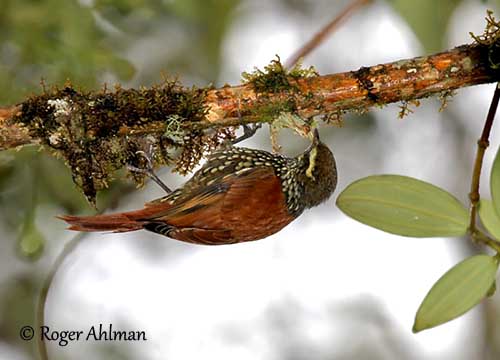
As a resident species, the Pearled Treerunner is territorial and is suspected to remain within its small territory throughout the year.
The courtship displays of this species are unknown. Among the Furnariidae, some species perform wing-raising and wing-flapping, others erect the throat feathers or raise the crown feathers.
Regarding the beautiful and interesting plumage pattern of the Pearled Treerunner, we can suggest that the teardrop-shaped spots of the breast are enhanced by adapted postures and behaviour, like the conspicuous white supercilium. But more studies are required.
The Pearled Treerunner is resident in its range.
As a resident species living and foraging in dense vegetation, it tends to have mostly rounded wings and flies only between its foraging sites.
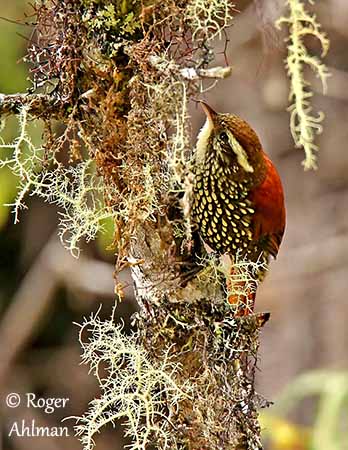
REPRODUCTION OF THIS SPECIES:
The Pearled Treerunner is probably monogamous.
From an observation of a nest in NW Ecuador, the nest is a tightly woven ball of moss and rootlets with a side entrance. This entrance is 3,5 cm wide, 2 cm high and 3 cm long. It is concealed by hanging loose moss. The nest is supported by the branch and the entrance is projecting downwards along the edge of the branch.
The nest-chamber is spherical and 10-12 cm in diameter. It is made with rootlets and grass blades, and lined with animal hair, bark strips and some treefern scales.
The walls of the nest are thick (1,5 to 2,5 cm) and made with compacted living moss. The nest is completely embedded in the growing moss and epiphytes.
Such nest is placed in tree, up to 20-21 metres above the ground.
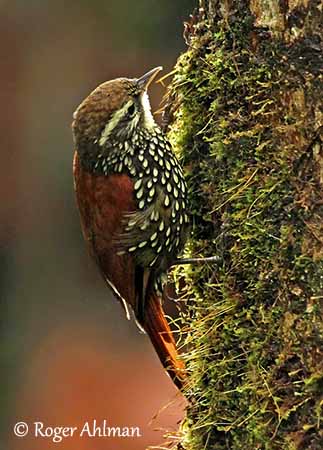
Following some similarities with the Spotted Barbtail (Premnoplex brunnescens), the female Pearled Treerunner probably lay two eggs too.
Fledglings can be seen in June in Venezuela, in May in Colombia, in July in C Peru and in March and December in C Bolivia.
PROTECTION / THREATS / STATUS:
The Pearled Treerunner is fairly common in suitable habitat, and occurs in several protected areas and national parks. This species is able to adapt to mild forest fragmentation and disturbance.
The population appear stable and currently, the Pearled Treerunner is evaluated as Least Concern.
